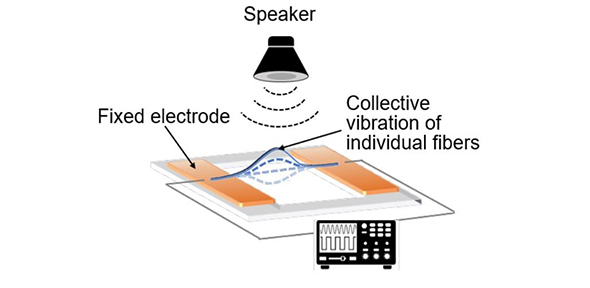A bio-inspired acoustic sensor that ‘feels’ its environment in a similar way to how a spider feels acoustic vibrations in its web, can successfully convert sound into power, Cambridge researchers have found.
This broad bandwidth acoustic sensor could potentially inspire the next-generation of integrated smart home and personal devices, such as intelligent windows, wearable sensors and breathable sensors.
Dr Shery Huang
The electronic device, which detects sound levels, makes use of a polymer nanofibre mesh to generate an electric charge when activated. The result is a self-powered sensor of high sensitivity and transparency, with a broad audible frequency bandwidth, making it potentially suitable for use in a number of applications, ranging from environmental detection through to biomedical diagnostics and the Internet of Things (IoT) 1. The results of the study are published in the journal Small.
Using a new fibre production method called dynamic near-field electrospinning (dNFES), a dynamic electrical force accurately guides the assembly of piezoelectric-active nanofibres to form the sensor, allowing the lightweight and flexible nanofibres to freely vibrate under the acoustic field (in this instance, a speaker) in a collective manner. The collective motion of the nanofibres is driven by the airflow under the acoustic field, and when these individual nanofibres vibrate, an output voltage is generated.

Credit: Shery Huang.
Results have shown that the free-standing sensing elements of the nanofibre mesh is sensitive to acoustic waves from 200 to 5000 Hz, covering most of the common sound frequencies encountered in our daily life. This bears similarities to certain ultra-small spider silks that have been found to possess high sensitivity and efficiency in detecting sound waves from infrasound to ultrasound 2.
During the dNFES process, lead author and PhD student Andy Wang, a member of the Department's Biointerface Research Group, observed a ‘jet splitting-whipping phenomenon’ produced by the distribution of the static field constantly changing during the spinning process. When activated by sound, the long spanning suspended nanofibre structures appear to be ‘dancing’ as the sound signals are captured and converted to power. The process results in a mesh of suspended nanofibres bonded to the surface of the electrodes, which become denser as the static field increases.
Observed under a high-speed camera, when activated by sound, the long spanning suspended nanofibre structures vibrate and appear to ‘dance’ as the sound signals are captured and converted to power. Credit: Shery Huang, YouTube.
Dr Shery Huang, Group Leader of the Biointerface Research Group, said the combination of materials used to generate an electric charge, coupled with the high transparency of the nanofibres, means the sensor could potentially inspire the next-generation of integrated smart home and personal devices, such as intelligent windows, wearable sensors and breathable sensors.
“What we have developed is a broad bandwidth acoustic sensor inspired by the acoustic sensing mechanism of spider silk that is strong, highly sensitive, transparent and efficient,” she said. “In order to emulate the effect of the spider silk, we needed the sensing elements of our acoustic sensor to be in the nanoscale, flexible, of low packing density, and crucially, free-standing, so that the motion of the nanofibres could be easily driven by the airflow under the acoustic waves at various frequencies.
“There are added benefits to be had, as the high transparency of the nanofibre mesh makes it suitable for potential integration with optoelectronic devices, such as optical and gas sensors, with the ability to enable a highly integrated sensing platform that can both ‘hear’ and ‘see’.”
Reference:
Wenyu Wang; Patrick N. Stipp; Karim Ouaras; Saeed Fathi; Yan Yan Shery Huang. ‘Broad Bandwidth, Self‐Powered Acoustic Sensor Created by Dynamic Near‐Field Electrospinning of Suspended, Transparent Piezoelectric Nanofiber Mesh’. Small (2020). DOI:10.1002/smll.202000581
1 IoT refers to the internet connection of physical objects, where physical objects are coupled with digital monitoring and analytics capabilities.

